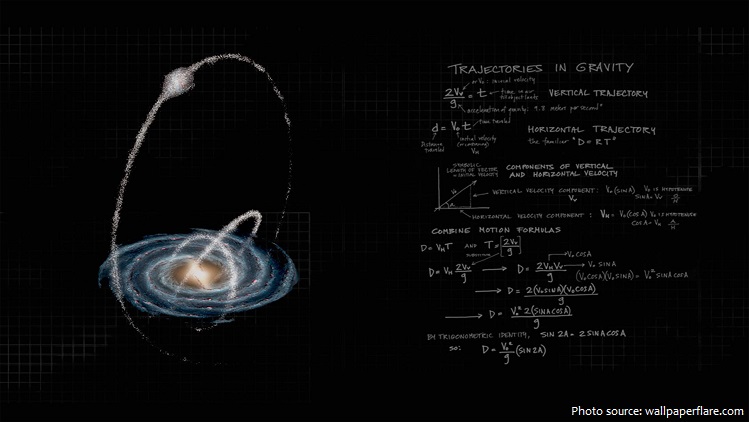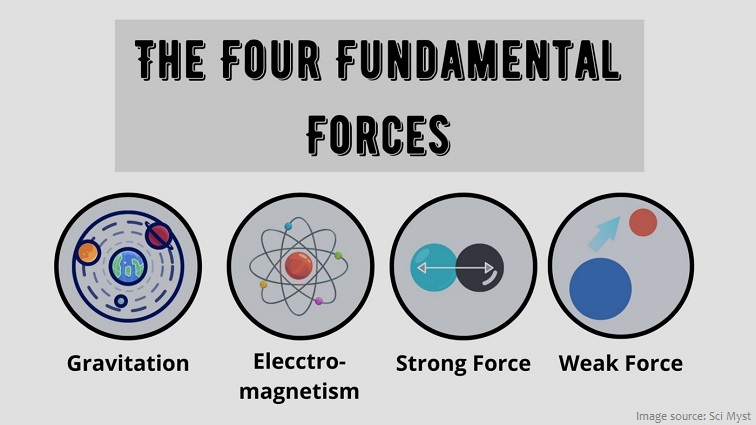
Gravity, or gravitation is one of the fundamental forces of the universe.
It is by far the weakest known force in nature and thus plays no role in determining the internal properties of everyday matter.
On the other hand, through its long reach and universal action, it controls the trajectories of bodies in the solar system and elsewhere in the universe and the structures and evolution of stars, galaxies, and the whole cosmos.
Newton’s law of gravitation, statement that any particle of matter in the universe attracts any other with a force varying directly as the product of the masses and inversely as the square of the distance between them. Understanding the law of gravity, one of the fundamental forces of physics, offers profound insights into the way our universe functions.

The famous story that Isaac Newton came up with the idea for the law of gravity by having an apple fall on his head is not true, although he did begin thinking about the issue on his mother’s farm when he saw an apple fall from a tree. He wondered if the same force at work on the apple was also at work on the moon. If so, why did the apple fall to the Earth and not the moon?
Gravity is most accurately described by the general theory of relativity (proposed by Albert Einstein in 1915), which describes gravity not as a force, but as a consequence of masses moving along geodesic lines ina curved spacetime caused by the uneven distribution of mass.
On Earth all bodies have a weight, or downward force of gravity, proportional to their mass, which Earth’s mass exerts on them. Gravity is measured by the acceleration that it gives to freely falling objects. At Earth’s surface the acceleration of gravity is about 9.8 metres (32 feet) per second per second. Thus, for every second an object is in free fall, its speed increases by about 9.8 metres per second. At the surface of the Moon the acceleration of a freely falling body is about 1.6 metres per second per second.

The launch of space vehicles and developments of research from them have led to great improvements in measurements of gravity around Earth, other planets, and the Moon and in experiments on the nature of gravitation.
Large parts of Canada have less gravity than the rest of Earth. The phenomenon was discovered in the 1960s.
According to one of his students, Galileo did a famous experiment about gravity where he dropped balls from the Tower of Pisa. He later rolled balls down inclines. With these experiments, Galileo showed that gravitation accelerates all objects at the same rate regardless of weight.

Jupiter is the planet with the strongest pull of gravity in the Solar System. If we were able to stand on the surface of Jupiter, we would weigh three times as much as we would weigh on Earth. The only other object in the Solar System with a stronger pull of gravity is the Sun.
A black hole is a region of spacetime where gravity is so strong that nothing — no particles or even electromagnetic radiation such as light — can escape from it. The theory of general relativity predicts that a sufficiently compact mass can deform spacetime to form a black hole.
There are four fundamental interactions known to exist: the gravitational and electromagnetic interactions, which produce significant long-range forces whose effects can be seen directly in everyday life, and the strong and weak interactions, which produce forces at minuscule, subatomic distances and govern nuclear interactions. Gravity is the weakest of the four fundamental interactions of physics.

The gravitational force equivalent, or, more commonly, g-force, is a measurement of the type of force per unit mass – typically acceleration – that causes a perception of weight, with a G-force of 1 G equal to the
conventional value of gravitational acceleration on Earth, g, of about 9.8 m/s2. Since g-forces indirectly produce weight, any G-force can be described as a “weight per unit mass”. When the g-force is produced by the surface of one object being pushed by the surface of another object, the reaction force to this push produces an equal and opposite weight for every unit of an object’s mass. The types of forces involved are transmitted through objects by interior mechanical stresses. Gravitational acceleration is the cause of an object’s acceleration in relation to free fall.
Weightlessness is the complete or near-complete absence of the sensation of weight. This is also termed zero-G, although the more correct term is “zero G-force”. It occurs in the absence of any contact forces upon objects including the human body.

Current models of particle physics imply that the earliest instance of gravity in the Universe, possibly in the form of quantum gravity, supergravity or a gravitational singularity, along with ordinary space and time, developed during the Planck epoch (up to 10−43 seconds after the birth of the Universe), possibly from a primeval state, such as a false vacuum, quantum vacuum or virtual particle, in a currently unknown manner. Attempts to develop a theory of gravity consistent with quantum mechanics, a quantum gravity theory, which would allow gravity to be united in a common mathematical framework (a theory of everything) with the other three fundamental interactions of physics, are a current area of research.